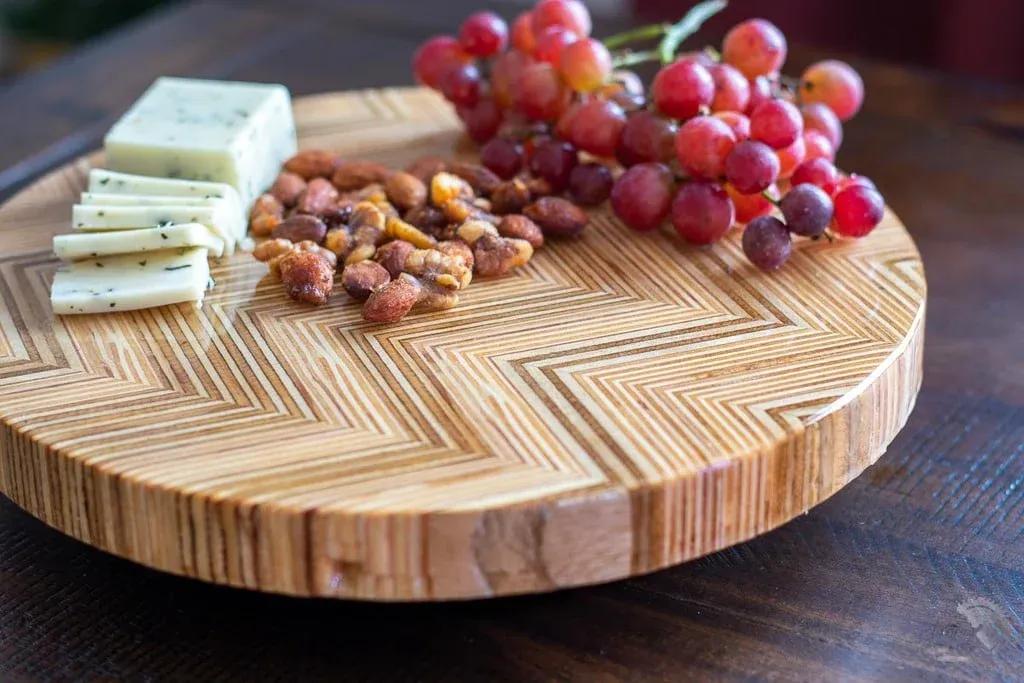What is a Lazy Susan?
Spinning into efficiency, Lazy Susans prove that sometimes the best solution is a simple turn away. These rotating game-changers transform cluttered corners and crowded tables into models of accessibility, making every meal and cabinet a well-oiled machine.

Photo credit: Anika Gandhi
I love lazy Susans. I remember my mom using one for the spices in our pantry and another when we were hosting family and friends for Thanksgiving.
From the bustling tables of dim sum restaurants to the depths of your grandmother's corner cabinet, lazy Susans have been quietly revolutionizing the way we dine and organize for centuries. These spinning platforms of convenience have a knack for showing up just when you need them most, whether you're reaching for that last dumpling or hunting for the elusive spice jar in the back of your pantry.
History of the Lazy Susan
A lazy Susan is a turntable (rotating tray) placed on a table or in a cabinet to aid in moving food or other items to users. It's like having a personal waiter that never tires, always at the ready to spin your condiments, spices, or that last slice of pizza right to you. Who knew laziness could be so productive?
The term "lazy Susan" first appeared in print in a 1917 Vanity Fair advertisement, but the concept itself is much older. The lazy Susan's beginnings can be traced as far back as early 14th century China, called 餐桌转盘 or "dinner-table turntables." Despite this, American folklore gives credit to Thomas Jefferson for his invention of the "dumbwaiter," which he made for his daughter Susan (not to be confused with the small elevator used for carrying food between floors).
Despite its name, the lazy Susan is anything but lazy. It's been hard at work in homes and restaurants for centuries, quietly revolutionizing the way we dine and organize. From elegant dining room centerpieces to ingenious cabinet storage solutions, this simple yet effective invention has spun its way into our hearts and homes.
Types of Lazy Susans
Lazy Susans come in various styles to suit different needs:
- Table-top lazy Susans: Perfect for dining tables, making it easy to share dishes in group settings.
- Cabinet lazy Susans: Ideal for corner cabinets or deep pantry spaces, maximizing storage efficiency.
- Two-tier lazy Susans: Offering double the storage in a compact space, great for organizing kitchen countertops.
- Refrigerator lazy Susans: Designed to fit in your fridge, keeping condiments and small items easily accessible.

The Functionality and Versatility of Lazy Susans
Lazy Susans are the unsung heroes of organization and accessibility. They can:
- Make hard-to-reach corners in cabinets easily accessible
- Streamline dining experiences by allowing easy sharing of dishes
- Organize spices, condiments, and small kitchen items efficiently
- Serve as a decorative and functional centerpiece for tables
- Enhance accessibility for those with limited mobility
Using Lazy Susans in Home Organization
These rotating wonders can be fantastic additions to various areas in your home:
- Kitchen: Use in cabinets, pantries, or on countertops for easy access to spices, oils, and other cooking essentials.
- Dining Room: Place a decorative lazy Susan at the center of your dining table for effortless sharing during meals.
- Bathroom: Organize toiletries, makeup, or skincare products on a countertop lazy Susan.
- Home Office: Keep stationery supplies organized and within reach.
- Craft Room: Store and access small craft supplies with ease.

Making the Most of Lazy Susans in Small Spaces
If you're dealing with limited space, a lazy Susan can be your secret weapon:
- Install a lazy Susan in deep or corner cabinets to utilize every inch of space.
- Use multi-tiered lazy Susans to maximize vertical storage on countertops or in cabinets.
- Opt for a lazy Susan with raised edges to prevent items from falling off during rotation.
Choosing the Right Lazy Susan
When selecting a lazy Susan, consider these factors:
- Size: Measure your space carefully to ensure a proper fit.
- Material: Options include wood, plastic, metal, or glass. Choose based on durability needs and aesthetic preferences.
- Weight Capacity: Ensure it can handle the items you plan to place on it.
- Bearing Type: Ball bearings offer smoother rotation, especially for heavier loads.
- Edges: Raised edges can prevent items from sliding off during rotation.
Care and Maintenance of Your Lazy Susan
To keep your lazy Susan spinning smoothly:
- Clean regularly with a damp cloth and mild soap.
- For wooden lazy Susans, apply mineral oil occasionally to prevent drying and cracking.
- Check and tighten any loose hardware periodically.
- Keep the central bearing clean and lubricated for smooth rotation.
- Avoid overloading beyond the recommended weight capacity.
Final Thoughts
From its mysterious origins to its place in modern homes, the lazy Susan has proven itself to be far more than just a spinning tray. It's a testament to the power of simple, effective design in solving everyday problems. Whether you're looking to maximize cabinet space, streamline your dining experience, or simply add a touch of convenience to your daily life, a lazy Susan might just be the solution you've been spinning in circles trying to find.
So why not give your kitchen organization a whirl with a lazy Susan? After all, sometimes the best way to get ahead is to keep things turning!
Check out kitchen organization solutions on Spoken and never overpay making your home beautiful!
Quick facts
Why do they call it a lazy Susan?
The name refers to the device's ease of use, but the exact origin of "Susan" is unclear.
What is the politically correct name for a lazy Susan?
Some alternatives are "rotating tray" or "turntable."
Why were servants called susans?
This is a misconception. The "lazy Susan" is simply a convenient rotating tray, not related to servants.
What do Chinese people call lazy Susan?
In Chinese, it's called "转盘" (zhuàn pán), meaning "rotating tray."
What is the difference between a lazy Susan and a Super Susan?
A Lazy Susan rotates on a central axis using a ball bearing mechanism, while a Super Susan uses a fixed shelf with rotating trays, offering a sturdier and quieter spin.
Are lazy Susans still popular?
Yes, lazy Susans remain a popular choice for organizing kitchen spaces, particularly in corner cabinets or as centerpieces on dining tables.
What else is a lazy Susan called?
A lazy Susan may also be referred to as a revolving tray or turntable, commonly used in dining settings to easily access condiments and dishes.
Is a lazy Susan worth it?
A lazy Susan is worth the investment for those seeking efficient storage and easy access to items in hard-to-reach areas, especially in kitchens or dining rooms.
What are the cons of lazy Susans?
The cons of lazy Susans include potential stability issues with heavier items, limited use in certain cabinet types, and occasional difficulty in cleaning the entire surface.

Dane Hurtubise
Co-founder & CEO of Spoken
Dane Hurtubise is the Co-founder & CEO of Spoken. He has led two venture-backed companies and is a two-time Y Combinator alum. Prior to Spoken, Dane sold his previous company, Parklet, to Greenhouse Software where he served as VP of Platform and Partnerships. An avid runner, cyclist, and Pilates enthusiast, Dane holds a BS in Electrical and Computer Engineering from the University of Texas at Austin.
Read more